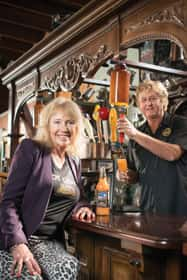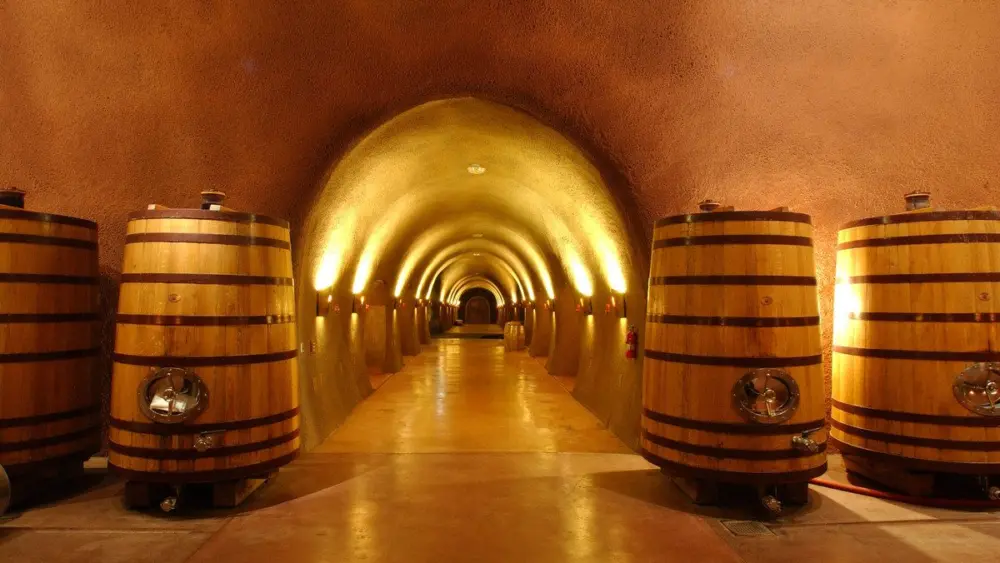Ace Cider Company
2064 Gravenstein Highway North
Sebastopol, CA, 95472
(707) 829-1101
Hours: Fridays only: 1-5 p.m.
Tasting fees: $10 for all nine ciders
Ciders offered: Nine ciders, including limited releases
Reservations: Available, but not required. Walk-ins welcome
Picnics: Outside seating available
Pets: Yes
Did You Know? Ace Cider’s Space Bloody Orange is a limited release celebrating Jeffrey House’s wife, Angela, who played Brea Tonnika in Star Wars Episode IV: A New Hope.
Leave it to the Brits to show us how to make hard cider. The whirlwind of popularity behind ultra-hoppy, skunky and bitter IPAs in the beer world have taken the lion’s share away from the traditionally crisp, fresh and just-not-too-sweet ciders. “We didn’t understand how cider wasn’t popular over here,” says Jason House, eastern division sales manager for Sebastopol’s Ace Cider Company. “In the United Kingdom, it’s 15 percent of the total beer and cider volume. In the United States, even with the cider renaissance of the last five years, it’s still has only 1 percent of the market share.”
One of the reasons behind cider’s lethargic growth in the states is due in part to some outdated legislation. Specific carbonation levels, a low ABV threshold for tax purposes and very specific language on what exactly a cider is (100 percent apple base. Even Ace’s Perry cider is an apple base) have lashed cider to the proverbial mast during the tempest of beer’s wanton growth.
But Ace is a different story.
In 1993, Englishman Jeffery House (Jason’s father), a veteran beer and cider importer labeled by his own team as “a mad genius of creativity,” reimagined the basics of cold cider and transformed it into a vicious competitor, ripping a bite out of the craft beverage market. “In the past couple years, we’ve experienced as much as 40 percent total growth per month,” says Liz Klaproth, administrative assistant and my personal pourer at Ace’s tasting room, which is nestled right behind its own production facility. And the growth is well deserved, as evidenced by the grove of different cider products poured before me.
 I started with the driest of the ciders, Blackjack. A limited-release item, Blackjack is a whopping 9 percent ABV Gravenstein apple cider aged in oak Chardonnay barrels. This isn’t a “take five on a summer’s afternoon” cider. It’s more like a competitor to champagne. And when I say dry, I mean it: It’s not like sucking on a wooden plank, but I wouldn’t try downing the 750 ml bottle without some accouterments—which is almost a shame, considering the crisp, ultra-refreshing and slightly sugary taste makes me want to tip the bottle upside-down and stop only for a breath of air. As a bonus, House will plant an apple tree for every bottle sold. I hope he’s prepared to plant an orchard.
I started with the driest of the ciders, Blackjack. A limited-release item, Blackjack is a whopping 9 percent ABV Gravenstein apple cider aged in oak Chardonnay barrels. This isn’t a “take five on a summer’s afternoon” cider. It’s more like a competitor to champagne. And when I say dry, I mean it: It’s not like sucking on a wooden plank, but I wouldn’t try downing the 750 ml bottle without some accouterments—which is almost a shame, considering the crisp, ultra-refreshing and slightly sugary taste makes me want to tip the bottle upside-down and stop only for a breath of air. As a bonus, House will plant an apple tree for every bottle sold. I hope he’s prepared to plant an orchard.The original apple cider remains one of Ace’s staples. The recipe hasn’t changed much since its 1994 debut, consisting of six dessert apples distilled into a 5 percent ABV summertime treat. Playing on the apple’s natural sweetness with classic pairings like pork chops and cheeses guarantees a great meal. A variant of this cider, Ace Honey, dials up the sugar with natural, locally raised honey. It makes for an excellent dessert drink, which not only brightens fresh fruit but helps wash down more decadent desserts without being cloyingly sweet.
A medium between the classic apple and the barrel-aged Blackjack is Joker, a 6.9 percent (remember the strict ABV requirements I talked about earlier? The cap on a specific tax bracket used to be 7 percent) ultra-dry apple base cider. The lower ABV compared to Blackjack makes Joker an awesome standalone drink, with grassy notes and a tart aftertaste activating that mouthwatering feeling you get when you sink your teeth into a perfectly ripe green apple. The Joker’s versatility also makes it a great mixer, changing the paradigm on mimosas, French 75s and Seelbachs.
Pears are getting more love in the cider world, these days. Ace’s Perry cider retains the apple base but makes the lopsided, sweeter fruit shine in its leading brand product. Not as versatile as the drier apple-only variety, this cider’s slightly sweeter, fuller mouthfeel taste balances funky cheeses like Gorgonzola and drunken goat, holding its own against the powerful forces of curdled milk.
The fruit-accentuated lines, which include pineapple, mixed berries, pumpkin spice and a limited-edition blood orange cider, bring the versatility of the apple base to light. Claproth urged me to experiment with mixing different flavors (my favorite mixing was the apple honey and mixed berry, giving a tart but mellow aftertaste dessert drink). Even though the fruits weren’t the base, they each took the spotlight in their respective drink, ranging from more bitter and fresh notes (blood orange) to sweet (pineapple) and savory (pumpkin spice). If you go to the tasting room, you can mix and match six packs. I recommend getting two of each fruit variety (you can’t put the blood orange in the six pack) and finding your own favorite combos.
Ace’s growth and expanding line of cider shows the craft beverage industry needs to make more room for one of the most versatile and underrated drinks on the market. The House family really shows us consumers want more cider, and they don’t plan on slowing down anytime soon.




